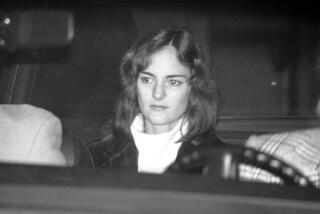Prosecutors Cast Net in Trial of SLA Figure
At the attempted murder conspiracy trial of Sara Jane Olson, purported former SLA revolutionary, prosecutors are seeking to use the testimony of a deceased hardware store owner and evidence of Symbionese Liberation Army crimes unrelated to Olson.
Prosecutors filed a motion arguing that the 1975 grand jury testimony of James Marshall be admitted as evidence because although he is no longer alive, his “testimony is simple, straightforward and unequivocal.”
In another motion filed Tuesday, prosecutors asked to present evidence of a long list of Symbionese Liberation Army crimes unconnected to Olson as a means of corroborating the testimony of witness Patricia Hearst.
Evidence about those activities “is necessary to show the defendant’s and her co-conspirator’s commitment to the common design and their active participation,” according to the prosecutors’ motion.
“The credibility of Patricia Hearst will come under great scrutiny by the defense,” according to the motion by Deputy Dist. Attys. Michael Latin and Eleanor Hunter.
“One of the focuses, if not the main focus, of the defense case will be to destroy Ms. Hearst. Ms. Hearst will commit the ultimate sin, according to the manifesto of the SLA, by cooperating . . . and telling the truth about the SLA and their activities when she testifies. Her testimony will undeniably be powerful evidence of the defendant’s guilt.”
But defense attorneys Stuart Hanlon and Susan B. Jordan filed a motion urging exclusion of 23 separate criminal acts that are not part of the charges against Olson, including the kidnapping of Hearst and a bank robbery/murder.
“To strengthen its otherwise weak case on the offenses charged, the prosecution seeks to admit all real and imaginary alleged SLA crimes,” said the defense motion. “Absent the inflammatory impact these offenses will have on the jury, it will be impossible to convict defendant of the charged offense.”
Hearst is a reluctant witness. She has made public statements pointing out that as a convicted felon she would not make a very reliable witness in the case.
In 1976, Olson--then known as Kathleen Soliah--was indicted by a Los Angeles County grand jury and charged with conspiracy to kill police officers by planting bombs under squad cars in August 1975. During her years as a fugitive, she built a comfortable life as a doctor’s wife and mother of three girls. She was active in church and community groups until she was arrested in June near her home in St. Paul, Minn.
Olson has pleaded innocent and is free on $1 million bail. Her trial is set to begin Feb. 7, and a pretrial hearing is scheduled for Monday.
Olson’s attorneys previously argued in motions to exclude Marshall’s 25-year-old grand jury testimony. In that testimony, Marshall identified a picture of Olson. But his description of the woman involved in the purchase of bomb parts from his hardware store was contradictory. Olson is slender with an angular face, but Marshall described a heavy-set woman with a round face.
“Mr. Marshall’s identification was unreliable even when given,” Hanlon and Jordan said in their papers. “His description fits someone who looked totally different than the defendant in both height, weight and distinguishing features.”
Prosecutors, however, said in their motion that the defense has selected “portions of the testimony, taking them out of context, and then weaving them with inaccurate descriptions of prior events.”
More to Read
Sign up for Essential California
The most important California stories and recommendations in your inbox every morning.
You may occasionally receive promotional content from the Los Angeles Times.









